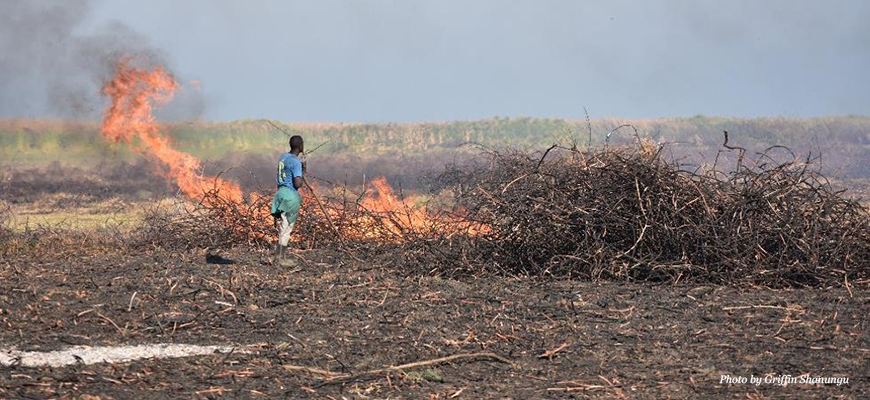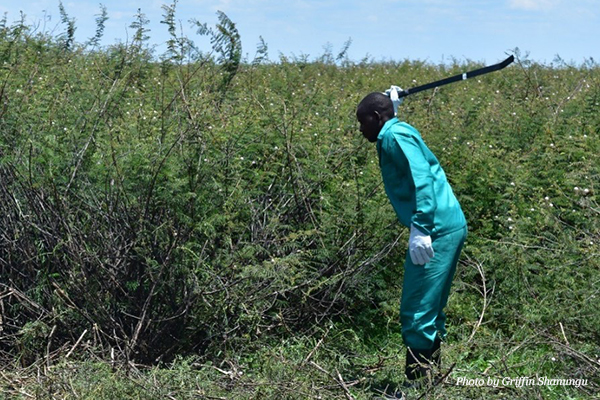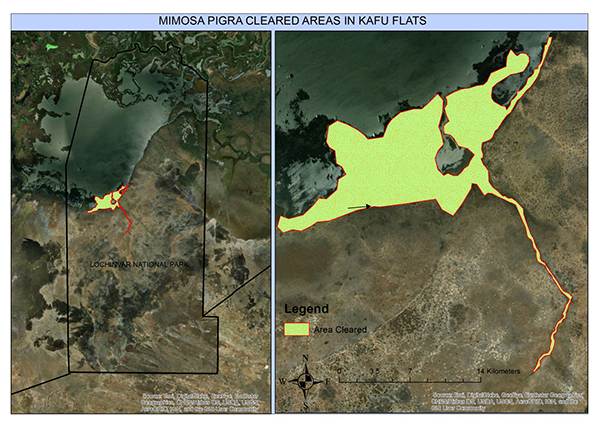
Garlic mustard, black locust and buckthorn… At the International Crane Foundation’s headquarters in Wisconsin, these three plant species are on the most wanted list of invasive species that our staff and volunteers work to eradicate each year. We remove these species as part of the broader habitat restoration program at our headquarters, which serves as both a living classroom and a home to many species of native plants and animals.
Invasive species are a threat to native plants and animals – including cranes – throughout the world. In the Kafue Flats of Zambia on the Kafue River, a tributary of the Zambezi River in Southern Africa, our team is removing Mimosa pigra, an invasive, tropical prickly shrub that is choking wetlands needed by Wattled Cranes and other wildlife. The target is to remove 95 percent of the weed. Mimosa is originally from South America and may have been introduced deliberately as a live fence or inadvertently.

We have employed 150 workers from local communities to physically cut mimosa using hand-held tools such as machetes and slashers. The strategy adopted for the physical removal of the shrub is to start clearing mimosa on its invasion front first, targeting small, founder populations and then advancing toward larger, well-established infestations. The workers clear the growths of mimosa using a procedure that removes the plants and reduces the seed bank. Mimosa plants are cut to ground level. The cut stems with foliage are left to dry and later burned. Burning helps destroy the mimosa seeds on the soil surface and also triggers native seed germination in the seed bank below the invasive shrub.
Following burning, we counted an average of 1,100 seedlings in a one meter by one meter quadrant, which illustrates how mimosa can rapidly regenerate. Burning and cutting stimulate seed germination and regrowth, hence the adoption of an integrated approach, which includes physical, chemical and biological control. We are waiting for approval from the Zambia Environmental Management Agency for permission to apply herbicide on any remaining stumps and roots to help inhibit plant regeneration.

Our next step is to import a species of moth – Carmenta mimosa – that will be used as a future biological control agent for mimosa in Zambia. The moth larvae burrow into the mimosa plant, feeding on the plant tissue and eventually weakening and killing it. We have secured the permit to import the moths from the Zambia Agricultural Research Institute. The moths will be collected in Australia and transported to Zambia by the Centre for Agriculture and Biosciences International (CABI) Africa, who will also provide training and other technical guidance in handling and monitoring the moths in critical areas, such as Lochinvar National Park and elsewhere.
Through this project, we hope to develop effective techniques for controlling the spread of mimosa, which can be applied in other areas. In the United States, a similar infestation of native black mangrove on the Texas gulf coast is choking potential future habitat for Whooping Cranes. Warming temperatures are allowing the mangroves to spread north into areas that in the past were too cold for this species. As our climate and environments change, we must continue to confront new challenges for crane conservation and healthy ecosystems.

 This project is led by Griffin Shanungu, Zambia Country Coordinator, and Mwape Sichilongo, Southern African Floodplains Regional Manager. Click here to learn more about our work in Sub-Saharan Africa.
This project is led by Griffin Shanungu, Zambia Country Coordinator, and Mwape Sichilongo, Southern African Floodplains Regional Manager. Click here to learn more about our work in Sub-Saharan Africa.
